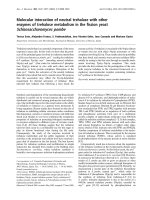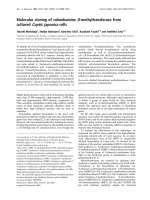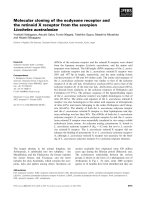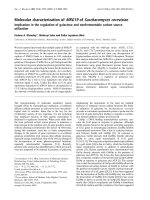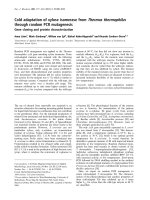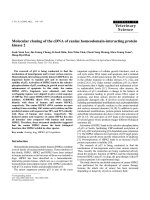Báo cáo Y học: Molecular cloning of columbamine O-methyltransferase from cultured Coptis japonica cells pot
Bạn đang xem bản rút gọn của tài liệu. Xem và tải ngay bản đầy đủ của tài liệu tại đây (513.99 KB, 9 trang )
Molecular cloning of columbamine
O
-methyltransferase from
cultured
Coptis japonica
cells
Takashi Morishige
1
, Emilyn Dubouzet
2
, Kum-Boo Choi
2
, Kazufumi Yazaki
1,2
and Fumihiko Sato
1,2
1
Division of Applied Life Sciences, Graduate School of Agriculture, Kyoto University, Japan;
2
Division of Integrated Life Science,
Graduate School of Biostudies, Kyoto University, Japan
To identify all of the O-methyltransferase genes involved in
isoquinoline alkaloid biosynthesis in Coptis japonica cells, we
sequenced 1014 cDNA clones isolated from high-alkaloid-
producing cultured cells of C. japonica.Amongthem,we
found all three reported O-methyltransferases and an
O-methyltransferase-like cDNA clone (CJEST64). This cDNA
was quite similar to S-adenosyl-
L
-methionine:coclaurine
6-O-methyltransferase and S-adenosyl-
L
-methionine:iso-
flavone 7-O-methyltransferase. As S-adenosyl-
L
-methion-
ine:columbamine O-methyltransferase, which catalyzes the
conversion of columbamine to palmatine, is one of the
remaining unelucidated components in isoquinoline alkaloid
biosynthesis in C. japonica, we heterologously expressed the
protein in Escherichia coli and examined the activity of
columbamine O-methyltransferase. The recombinant
protein clearly showed O-methylation activity using
columbamine, as well as (S)-tetrahydrocolumbamine,
(S)-, (R,S)-scoulerine and (R,S)-2,3,9,10-tetrahydroxypro-
toberberine as substrates. This result clearly indicated that
EST analysis was useful for isolating the candidate gene in a
relatively well-characterized biosynthetic pathway. The
relationship between the structure and substrate recognition
of the O-methyltransferases involved in isoquinoline alka-
loid biosynthesis, and a reconsideration of the biosynthetic
pathway to palmatine are discussed.
Keywords: alkaloid biosynthesis; methyltransferase; Coptis
japonica; palmatine; columbamine.
Higher plants produce a wide variety of chemicals, including
more than 25 000 terpenoids, approximately 12 000 alka-
loids and approximately 8000 phenolic compounds [1].
Thus, secondary metabolism in plant cells could be a useful
source of these chemicals, especially alkaloids, many of
which have high biological activities and are used as
medicines.
Isoquinoline alkaloid biosynthesis is the most well-
characterized pathway in plant cells and some biosynthetic
genes have been isolated [2,3 and references cited therein].
However, the conventional method for isolating the corres-
ponding biosynthetic genes based on the purified enzymes is
a rate-limiting step for characterization, even though this
approach can be very useful when we have no information
about the desired enzyme(s). Although a useful approach is
to isolate a group of genes based on their structural
similarity, such as O-methyltransferase (OMT) or P450
motifs, this approach faces the problem of identifying
biological activity due to the high redundancy of related
genes.
On the other hand, recent scientific and technological
advances now enable the high-through-put sequencing of
cDNA clones, and we can analyze these expressed sequence
tag (EST) using on-line databases and search tools. These
ESTs are also useful for evaluating mRNA transcripts to
estimate their biological function.
To evaluate the effectiveness of this technology, we
sequenced the cDNA clones isolated from high-alkaloid-
producing cultured cells of Coptis japonica.Asweprevi-
ously characterized some of the OMTs in isoquinoline
alkaloid biosynthesis in Coptis cells, we focused on the
isolation of the another unelucidated OMT in this biosyn-
thetic pathway; i.e. S-adenosyl-
L
-methionine:columbamine
O-methyltransferase (CoOMT), which catalyzes the transfer
of the S-methyl group of S-adenosyl-
L
-methionine (Ado-
Met) to the 2-hydroxyl group of columbamine to form
palmatine [4] (Fig. 1).
Methyltransferases are essential for directing inter-
mediates to specific biosynthetic pathways [5]. Each meth-
yltransferase in the biosynthesis of palmatine (i.e.
S-adenosyl-
L
-methionine:norcoclaurine 6-O-methyltransf-
erase (6OMT) [6–10]; S-adenosyl-
L
-methionine:coclaurine
N-methyltransferase (CNMT) [11–14]; S-adenosyl-
L
-methi-
onine:3¢-hydroxy-N-methylcoclaurine 4¢-O-methyltrans-
ferase (4¢OMT) [10,15]; S-adenosyl-
L
-methionine:scoulerine
9-O-methyltransferase (SMT) [16–18]; and CoOMT [4])
has strict substrate specificity, despite the structural
Correspondence to F. Sato, Division of Integrated Life Sciences,
Graduate School of Biostudies, Kyoto University, Kyoto,
606-8502, Japan. Fax: + 81 75 753 6398, Tel.: + 81 75 753 6381,
E-mail:
Abbreviations:OMT,O-methyltransferase; EST, expressed sequence
tag; CoOMT, S-adenosyl-
L
-methionine:columbamine O-methyl-
transferase; AdoMet, S-adenosyl-
L
-methionine; AdoHcy,
S-adenosyl-
L
-homocysteine; 6OMT, S-adenosyl-
L
-methionine:norco-
claurine 6-O-methyltransferase; CNMT, S-adenosyl-
L
-methionine:
coclaurine N-methyltransferase; 4¢OMT, S-adenosyl-
L
-methionine:3¢-
hydroxy-N-methylcoclaurine 4¢-O-methyltransferase; SMT,
S-adenosyl-
L
-methionine:scoulerine 9-O-methyltransferase; IOMT,
S-adenosyl-
L
-methionine:isoflavone 7-O-methyltransferase; LC-MS,
liquid chromatography-mass spectrometry.
Note: The nucleotide sequence for columbamine O-methyltransferase
has been deposited in the GenBank database under GenBank
Accession Number AB073908.
(Received 13 March 2002, revised 2 July 2002,
accepted 20 September 2002)
Eur. J. Biochem. 269, 5659–5667 (2002) Ó FEBS 2002 doi:10.1046/j.1432-1033.2002.03275.x
similarities of the various substrates. Due to their
importance in the production of pharmaceutically
important alkaloids and their strict substrate recognition,
these methyltransferases, especially OMTs, have been
well characterized [6–17] and their cDNA has been
isolated [10,14,18]. However, CoOMT was characterized
using only partially purified enzymes [4] and its cDNA
has not yet been isolated.
We report here the first isolation of CoOMT from
C. japonica ESTs, the expression of functionally active
recombinant enzyme, and its characterization. Characteri-
zation of its specificity showed that Coptis CoOMT could
methylate tetrahydrocolumbamine as well as columbamine,
and suggests that the biosynthetic pathway to palmatine
should be reconsidered.
EXPERIMENTAL PROCEDURES
Cultured cells
The original cultured cells were induced from rootlets of
C. japonica Makino var. dissecta (Yatabe) Nakai. A cell line
(156–1) that produces large amounts of alkaloids was
subcultured as described elsewhere [19]. Ten-day-old-cul-
tured cells were harvested and used for the extraction of
mRNA.
Chemicals
(R,S)-Norlaudanosoline and (R,S)-laudanosoline were
purchased from Aldrich, and berberine was from Wako
Pure Chemical Industries, Ltd. (R)- and (S)-coclaurine were
the gift of Dr Nagakura of Kobe Women’s College of Phar-
macy, and (S)-reticuline was a gift from Dr Facchini of the
University of Calgary. The other alkaloids were generous
gifts from Mitsui Petrochemical Industries, Ltd.
Chemical synthesis of columbamine
Columbamine was synthesized and purified from berberine
by two-step reactions according to the method of Cava and
Reed [20,21].
Construction and sequencing of cDNA library
of
C. japonica
Poly(A)
+
RNA was isolated, and a cDNA library was
constructed as described elsewhere [14]. The cDNA
Fig. 1. Schematic biosynthetic pathway of
palmatine. Dotted lines and question marks
indicate the possible pathway based on the
present findings.
5660 T. Morishige et al.(Eur. J. Biochem. 269) Ó FEBS 2002
fragments were ligated into pDR196 vector [22]. Sequen-
cing of the cDNA library was performed using a
MegaBACE 1000 DNA Sequencing System (Amersham
Pharmacia Biotech) in accordance with the manufacturer’s
instructions. Overall, 1014 ESTs were obtained in suffi-
cient length and these sequences were annotated using a
BLAST
search ( />BLAST
/) (E.
Dubouzet et al. in preparation). During the
BLAST
search,
we found an unidentified OMT cDNA (CJEST64) in
addition to the sequences of reported Coptis OMTs. To
obtain more information about the sequence of this
CJEST64, the complete cDNA sequence was determined
with deletion clones of CJEST64 and a DSQ-2000 L
DNA sequencer (Shimadzu) with fluorescein isothiocya-
nate-labelled primers.
Isolation of full-length cDNA
To isolate full-length cDNA of the unknown OMT
(CJEST64), rapid amplification of the 5¢ end of cDNA
(5¢RACE) was carried out using a Marathon cDNA
Amplification Kit (Clontech). Gene-specific antisense primer
(5¢-CTCCAAACTGAGAACTCTTCCG-3¢)wasdesigned
based on the nucleotide sequence of CJEST64. PCR
fragments were isolated and subcloned into pT7Blue vector
(Novagen), and their nucleotide sequences were determined.
Construction of an expression vector for full-length
CJEST64
An expression vector was constructed for full-length
CJEST64 cDNA without the fused peptide derived from
the vector sequence in pET-21d vector (Novagen). The full-
length cDNA was first prepared by PCR with a Marathon
adaptor primer (Clontech) and a forward primer
5¢-TTGTTCTAAGGCCATGGTATCTCCG-3¢ to intro-
duce a NcoI site (CCATGG) at the start codon. A
restriction site was introduced by changing the underlined
base. pET-21d was digested with NcoIandXhoI, and the
PCR product was ligated into the vector. This construct was
completely sequenced to confirm that no changes were
introduced by the subcloning process.
Heterologous expression of full-length CJEST64
in
Escherichia coli
The expression vector for full-length CJEST64 cDNA was
introduced into Escherichia. coli BL21 (DE3). After induc-
tion with 1 m
M
isopropylthiogalactoside, E. coli cells were
incubated at 25 °C for 5 h, and then harvested and
extracted in extraction buffer (0.1
M
Tris/HCl, pH 8.0,
containing 10% glycerol, 5 m
M
EDTA and 10 m
M
2-mercaptoethanol). After centrifugation at 12 000 g for
10 min, the supernatant was desalted through an NAP-5
column (Amersham Pharmacia Biotech) and used to
measure CoOMT activity.
Measurement of
O
-methylation activity
The standard CoOMT reaction mixture (50 lL) consisted
of 100 m
M
potassium phosphate (pH 7.8), 25 m
M
sodium
ascorbate, 1 m
M
columbamine, 3 m
M
AdoMet and the
enzyme preparation (c.100lg protein). The assay mixture
was incubated at 30 °C for 1 h, after which the reaction was
terminated by the addition of methanol. After protein
precipitation, the reaction product was detected by reversed-
phase HPLC (mobile phase, 35% acetonitrile/H
2
O contain-
ing 1% acetic acid; column, TSKgel ODS-80Tm (4.6 ¥
250 mm; TOSOH); flow rate, 0.5 mLÆmin
)1
; detection,
absorbance measurement at 280 nm. Mass spectra were
obtained with an LCMS-2010 (Shimadzu).
Tetrahydrocolumbamine was prepared from scoulerine
via ascoulerine9-O-methyltransferase (SMT) reaction. The
SMT reaction was carried out as described previously [18]
with a modification. In brief,the expression of SMT in E. coli
was induced using a pET expression system and the E. coli
Fig. 2. Amino acid sequence alignment of the
O-methyltransferases in palmatine biosynthesis.
Motifs A, B, C; conserved sequence motifs in
plant S-adenosyl-
L
-methionine-dependent
methyltransferase. Amino acids conserved in
all of the sequences are boxed and similar ones
are shaded.
Ó FEBS 2002 Coptis columbamine O-methyltransferase (Eur. J. Biochem. 269) 5661
lysate was prepared. The SMT reaction mixture consisted of
100 m
M
Tris/HCl (pH 8.0), 25 m
M
sodium ascorbate, 1 m
M
(S)-scoulerine, 5 m
M
AdoMet and the enzyme preparation.
The reaction mixture was incubated at 30 °C for 3 h. In this
reaction, scoulerine was converted into tetrahydrocolumb-
amine. After the enzyme reaction was terminated by the
addition of 0.5
M
sodium carbonate, the reaction product
was extracted twice with ethyl acetate. The extracted product
was dried and used for further characterization. HPLC
analysis showed that tetrahydrocolumbamine prepared was
80% pure and contained unconverted scoulerine. Because
scoulerine was a poor substrate for CoOMT, we analyzed
substrate affinity of CoOMT for tetrahydrocolumbamine
using this 80% pure tetrahydrocolumbamine.
To quantify the enzymatic activity of CoOMT, the
transfer of the
3
H-labeled methyl group of S-adenosyl-
L
-
[methyl-
3
H]methionine (0.5 MBqÆlmol
)1
)(PerkinElmer
Life Sciences) to the product was measured as described
elsewhere [7]. The kinetic constants of the crude enzyme
were determined by varying the concentration of alkaloid
substrates, but keeping the concentration of
3
H-labeled
AdoMet fixed at 1 m
M
then apparent K
m
and V
max
values
were calculated.
Other methods
The subunit molecular mass of the enzyme was deter-
mined by SDS/PAGE (12.5% polyacrylamide). Protein
Fig. 3. Phylogenic tree of plant S-adenosyl-
L
-methionine-dependent O-methyltransferase
sequences. OMT protein sequences obtained
from GenBank
TM
were used to build the tree.
Accession numbers are indicated in paren-
thesis. Overall, 20 sequences were aligned by
the multisequence alignment program in
GENETYX
-
MAC
ver.1.1 (Software Develop-
ment, Inc. Tokyo, Japan) using the
UPGMA
(unweighted pair group maximum average)
method.AEOMT,hydroxycinnamicacids/
hydroxycinnamoyl CoA esters O-methyl-
transferase.
5662 T. Morishige et al.(Eur. J. Biochem. 269) Ó FEBS 2002
concentration was determined according to Bradford [23]
with bovine serum albumin as a standard.
RESULTS
Sequence analysis of the OMT-like clone
A cDNA library was prepared from C. japonica cells that
produce large amounts of alkaloids, and its 1014 ESTs were
obtained (E. Dubouzet et al. in preparation). A
BLAST
search ( showed that
these sequenced clones included 4 clones of 4¢OMT, 2
clones of 6OMT and 4 clones of SMT. This result indicated
that this cDNA library was highly enriched with biosyn-
thetic genes involved in isoquinoline alkaloid biosynthesis.
Thus, we speculated that this library also included the gene
for the additional unelucidated OMT in isoquinoline
alkaloid biosynthesis in C. japonica,i.e.CoOMT.Infact,
a
BLAST
search identified a clone (CJEST64) which was quite
similar to isoflavone 7-O-methyltransferase (IOMT) and
6OMT.
Whereas CoOMT is found in the last step of palmatine
biosynthesis and 6OMT is found at an early step, we
examined the possibility that this CJEST64 was CoOMT.
As only a partial sequence was determined for the EST
project, full-length of CJEST64 was determined. The
sequence obtained further confirmed that CJEST64 was
similar to 6OMT, 4¢OMT and IOMT (data not shown),
although the sequence was not full-length based on
sequence alignment. Thus, the 5¢-fragment of CJEST64
was obtained by 5¢RACE and sequenced. Finally, full-
length cDNA was re-cloned from the cDNA library and the
expression vector was constructed as described below.
This full-length cDNA carried 1378 nucleotides, with an
open reading frame that encoded 351 amino acids (Fig. 2).
The deduced amino acid sequences had conserved putative
AdoMet binding domains at the C-terminal end (Fig. 2,
motifs A–C), like other OMTs [24]. This polypeptide had a
high degree of similarity (approximately 40% identity) to
Coptis 6OMT, Coptis 4¢OMT, IOMT of alfalfa [25], and
6a-hydroxymaackiain 3-O-methyltransferase of pea [26].
The deduced polypeptide showed a rather low identity
(21%) to SMT. Phylogenetic analysis clearly indicated that
this polypeptide belongs to the same branch as 6OMT and
4¢OMT (Fig. 3).
Expression of the full-length cDNA in
E. coli
We constructed the expression vector to produce recom-
binant proteins in Ecolito examine the activity of CoOMT.
We introduced an NcoI site into the cDNA to fit the
initiation codon in the E. coli expression vector pET-21d to
produce nontagged polypeptide. This construct was then
introduced into E. coli cells, and production of the recom-
binant protein was induced. The crude E. coli lysate was
used to detect CoOMT activity. SDS/PAGE analysis clearly
showed that transgene expression was successfully induced
and the subunit molecular mass was estimated to be
approximately 40 kDa (Fig. 4).
HPLC analysis of the reaction mixture clearly showed
that recombinant E. coli lysate had CoOMT activity (data
not shown). The control E. coli lysate with the pET-21d
vector showed no enzymatic activity. LC-MS analysis
Fig. 4. SDS/PAGE of E. coli crude extract expressing CJEST64.
Crude extracts of E. coli transformed with expression vector for
CJEST64 or control vector were separated by SDS/PAGE and stained
with Coomassie Brilliant Blue G-250. Lane 1, molecular mass markers;
lane 2, pET-CJEST64 (10 lg); lane 3, control vector (pET-21d)
(10 lg). Arrow indicates production of the expected recombinant
CoOMT.
Fig. 5. LC-MS analysis of the reaction product (A), authentic columb-
amine (B), authentic palmatine (C) and the control reaction (pET-21d)
(D). TIC, total ion chromatogram.
Ó FEBS 2002 Coptis columbamine O-methyltransferase (Eur. J. Biochem. 269) 5663
confirmed that palmatine was produced from columbamine
by recombinant E. coli lysate (Fig. 5), and that the
CJEST64 product was CoOMT.
Characterization of recombinant CoOMT
As CoOMT activity was identified, we further characterized
the enzyme properties of CoOMT using this crude recom-
binant enzyme. First, we optimized the pH conditions for
the CoOMT reaction using columbamine as a substrate.
Enzyme assays at various pH values indicated that the
optimum pH for the methylation of columbamine was
approximately 8.4. Whereas product inhibition of 6OMT
and SMT has been reported [8,17], berberine, one of the
end-products of isoquinoline alkaloid biosynthesis in Coptis
cells, did not inhibit CoOMT activity in the assay mixture at
2.5 m
M
.
Next, we determined the substrate specificity of CoOMT
using the incorporation of radioactivity from S-adenosyl-
L
-[methyl-
3
H]methionine into the products as an index
(Table 1). When columbamine was used as the control
substrate (i.e. relative incorporation 100%), the respective
relative activities with (S)- and (R,S)-scoulerine and
2,3,9,10-tetrahydroxyprotoberberine were 31, 22 and 14%,
whereas no significant methylation was found for other
substrates. The methylation of scoulerine and 2,3,9,10-
tetrahydroxyprotoberberine by CoOMT was further
confirmed by LC-MS (Fig. 6). Interestingly, mono- and
di-methylated products were formed from 2,3,9,10-tetra-
hydroxyprotoberberine by reacting with CoOMT. This
result indicated that the regio-specificity of CoOMT was
rather low.
Above result suggested that tetrahydroprotoberberine
should also be a good substrate for CoOMT. To confirm
this idea, tetrahydrocolumbamine was produced from
scoulerine by an SMT reaction, and the reaction pro-
duct, tetrahydrocolumbamine, was used in the successive
CoOMT reaction. Figure 6E,F show that a new reaction
product with a 14-m/z greater mass was detected.
To compare the substrate specificity, we determined the
kinetic constants of CoOMT for columbamine, tetrahydro-
columbamine and (S)-scoulerine. Substrate-saturation kin-
etics of the recombinant CoOMT prepared from E. coli for
these alkaloids were the typical Michaelis–Menten type.
Then, we calculated apparent K
m
and V
max
values by varying
the concentration of these alkaloids in the presence of 1 m
M
AdoMet. The respective K
m
values of CoOMT for columb-
amine, tetrahydrocolumbamine and (S)-scoulerine were
66 ± 18, 35 ± 18 and 173 ± 51 l
M
, and respective V
max
were 125 ± 12, 21 ± 7, and 6.9 ± 1.3 pkatÆmg protein
)1
.
Table 1. Transfer of [
3
H]-methyl group of S-adnosyl-
L
-methionine into different substrates by columbamine OMT. Values indicate the incorporation
of radioactivity from S-adenosyl-
L
-[methyl-
3
H]methionine into the product relative to columbamine. Other assay conditions are indicated in
Materials and methods. ND, not detected.
Substrate R1 R2 R3 R4 R5 Relative activity
Columbamine OCH
3
OH OCH
3
OCH
3
- 100%
2,3,9,10-Tetrahydroxyprotoberberine OH OH OH OH - 14%
(S)-Scoulerine OCH
3
OH OH OCH
3
- 31%
(R,S)-Scoulerine OCH
3
OH OH OCH
3
- 22%
(R,S)-2,3,9,10-Tetrahydroxy-
tetrahydroprotoberberine
OH OH OH OH - ND
(R,S)-6-O-Methylnorlaudanosoline OCH
3
OH OH OH H ND
(R,S)-Laudanosoline OH OH OH OH CH
3
ND
(R,S)-Norlaudanosoline OH OH OH OH H ND
(R,S)-Reticuline OCH
3
OH OH OCH
3
CH
3
ND
(S)-Reticuline OCH
3
OH OH OCH
3
CH
3
ND
(R,S)-Norreticuline OCH
3
OH OH OCH
3
HND
(S)-Coclaurine OCH
3
OH H OH H ND
(R)-Coclaurine OCH
3
OH H OH H ND
Caffeic acid OH - - - - ND
4-Hydroxy-3-methoxycinnamic acid OCH
3
ND
5664 T. Morishige et al.(Eur. J. Biochem. 269) Ó FEBS 2002
DISCUSSION
The present results indicate that high-through-put sequen-
cing of a cDNA library of high-metabolite-producing cells
and computer-assisted sequence analysis can be useful for
isolating a desired but not yet identified gene(s). Using this
strategy, we successfully identified cDNA of CoOMT
without purification of the enzyme from plant material.
Similar approaches have been reported to isolate enzyme in
peppermint oil gland cells [27]. Heterologously expressed
enzyme clearly showed CoOMT activity and provided a
sufficient amount of material for characterization, whereas
such characterization was only partial due to substrate
limitations. Further computer-assisted analyses for the
hydropathy and localization of CoOMT using the
SIGNAL
P
( and
PSORT
( programs indicated that CoOMT
was a cytosolic enzyme, whereas Berberis CoOMT has been
reported to be vesicle-bound [4].
This CoOMT is the fourth OMT isolated from C. japonica
cells to play a role in isoquinoline alkaloid biosynthesis. As
each enzyme shows distinct substrate specificity, we com-
pared the sequences of these OMTs. Surprisingly, CoOMT
was much more similar to 6OMT and 4¢OMT than SMT,
even though SMT catalyzes the O-methylation of a proto-
berberine alkaloid, like CoOMT. CoOMT showed 40%
identity to 4¢OMT. However, we did not detect recombinant
CoOMT in the crude extract of E. coli by an immunoblot
analysis with anti4¢OMT polyclonal antibodies. Multiple
sequence alignment of CoOMT and the biosynthetic
enzymes involved in benzylisoquinoline alkaloid biosynthe-
sis, including berberine bridge enzyme [28–30] and (S)-N-
methylcoclaurine 3¢-hydroxylase (CYP80B1) [31], also failed
to indicate any sequence homology (data not shown). A
comparison of CoOMT and CNMT only showed limited
sequence similarity in motif A, as seen between CNMT and
other OMTs [14]. It is not clear why the sequence of CoOMT
is so different from that of SMT.
The three-dimensional structures of IOMT and chalcone
OMT in flavonoid biosynthesis have recently been charac-
terized [32]. Multiple sequence alignment of Coptis OMTs,
including CoOMT, with OMTs in flavonoid biosynthesis
showed that the residues involved in AdoMet binding and
the catalytic residues were highly conserved, and the
methionine residues that interact with methyl group accep-
tor were also conserved. However, other substrate-binding
residues were not conserved (data not shown). The sequence
diversity in the substrate-binding site, which is expected to
be located in the N-terminal end of Coptis OMTs
(T. Morishige & F. Sato, unpublished data), is considerably
high. The sequence of CoOMT may be useful for under-
standing substrate binding and the enzyme structures in
isoquinoline alkaloid biosynthesis.
Our recombinant CoOMT also provides additional
information about the branching point in the late steps in
palmatine biosynthesis. Columbamine was once thought to
be the main substrate for palmatine biosynthesis in Berberis
wilsoniae and Berberis aggregata using partially purified
Fig. 6. LC-MS analysis of the CoOMT reaction products for (S)-scoulerine (A), 2,3,9,10-tetrahydroxyprotoberberine (C) and tetrahydrocolumbamine
(E), respectively. (B) (D) and (F) show the respective control reactions (pET-21d) for (S)-scoulerine, 2,3,9,10-tetrahydroxyprotoberberine and
tetrahydrocolumbamine. Products with a m/z increase of 14 mass units were observed only in the CoOMT reaction. Tetrahydrocolumbamine was
prepared by the SMT reaction and used in a successive CoOMT reaction without further purification. TIC, total ion chromatogram.
Ó FEBS 2002 Coptis columbamine O-methyltransferase (Eur. J. Biochem. 269) 5665
enzyme, as Berberis CoOMT could not methylate tetra-
hydrocolumbamine [4]. However, our findings clearly
indicate that tetrahydrocolumbamine can be a substrate
for the formation of tetrahydropalmatine (Fig. 6), which
can be easily converted to palmatine by (S)-tetrahydropro-
toberberine oxidase [33]. Our preliminary analyses also
showed that CoOMT had rather smaller K
m
value for
tetrahydrocolumbamine than columbamine, while the V
max
value for tetrahydrocolumbamine was also smaller than
that for columbamine. These data suggested that both
pathways might operate in Coptis cells. Differences in
substrate specificity have also been reported for the CNMT
of Coptis and Berberis, i.e. Coptis enzyme could N-methy-
late norlaudanosoline, whereas Berberis enzyme could not
[11,13]. These results suggest that the late biosynthetic
pathway should be re-examined in various plant species,
and that the pathway in secondary metabolism may vary
depending on the enzyme(s) that each plant has acquired
during its evolution.
ACKNOWLEDGEMENTS
We thank Dr N. Nagakura, Dr P. Facchini and Mitsui Petrochemical
Industries Ltd. for their generous gifts of the alkaloids. We also thank
Ms. L. Huang for her technical assistance with preparing columbamine.
We thank Dr W. Frommer of the University of Tuebingen for the gift
of pDR196 vector.
This research was supported in part by a Research for the Future
Program Grant (JSPS-RFTF00L01607) from the Japan Society for the
Promotion of Science (to F. S), and a fellowship from the Japan Society
for the Promotion of Science (to T. M).
REFERENCES
1. Croteau, R., Kutchan, T.M. & Lewis, N. (2000) Biochemistry
and Molecular Biology of Plants.(Buchanan,B.,Gruissem,W.&
Jones, R., eds), pp. 1250–1318. American Society of Plant
Physiologists, Rockville, Maryland.
2. Facchini, P.J. (2001) Alkaloid biosynthesis in plants: biochemistry,
cell biology, molecular regulation, and metabolic engineering
application. Annu. Rev. Plant Physiol. Plant Mol. Biol. 52,
29–66.
3. DeLuca, V. & Laflamme, P. (2001) The expanding universe of
alkaloid biosynthesis. Curr. Opin. Plant Biol. 4, 225–233.
4. Rueffer, M., Amann, M. & Zenk, M.H. (1986) S-adenosyl-
L
-methionine: columbamine-O-methyltransferase, a compartmen-
talized enzyme in protoberberine biosynthesis. Plant Cell Reports
3, 182–185.
5. Poulton, J.E. (1981) The Biochemistry of Plants. (Conn, E.E.,
ed.), Vol. 7, pp. 667–723. Academic Press, New York.
6. Rueffer, M., Nagakura, N. & Zenk, M.H. (1983) Partial puri-
fication and properties of S-adenosylmethionine:(R), (S)-norlau-
danosolin-6-O-methyltransferase from Argemone platyceras cell
cultures. Planta Med. 49, 131–137.
7. Mu
¨
ller, M.J. & Zenk, M.H. (1992) The norcoclaurine pathway is
operative in berberine biosynthesis in Coptis japonica. Planta Med.
58, 524–527.
8. Sato, F., Tsujita, T., Katagiri, Y., Yoshida, S. & Yamada, Y.
(1994) Purification and characterization of S-adenosyl-
L
-methio-
nine: norcoclaurine 6-O-methyltransferase from cultured Coptis
japonica cells. Eur. J. Biochem. 225, 125–131.
9. Hara,M.,Yazaki,K.,Tanaka,S.&Tabata,M.(1995)S-ade-
nosyl-
L
-methionine: norcoclaurine 6-O-methyltransferase from
Thalictrum minus cell cultures. Phytochemistry 38, 1131–1135.
10. Morishige, T., Tsujita, T., Yamada, Y. & Sato, F. (2000) Mole-
cular characterization of the S-adenosyl-
L
-methionine: 3¢-hyd-
roxy-N-methylcoclaurine 4¢-O-methyltransferase involved in
isoquinoline alkaloid biosynthesis in Coptis japonica. J. Biol.
Chem. 275, 23398–23405.
11. Frenzel, T. & Zenk, M.H. (1990) S-adenosyl-
L
-methionine:
3¢-hydroxy-N-methyl-(S) -coclaurine-4¢-O-methyltransferase, a
regio- and stereoselective enzyme of the (S)-reticuline pathway.
Phytochemistry 29, 3505–3511.
12. Wat, C.K., Steffens, P. & Zenk, M.H. (1986) Partial purification
and characterization of S-adenosyl-
L
-methionine: norreticuline
N-methyltransferases from Berberis cell suspension cultures.
Z. Naturforsch. 41c, 126–134.
13. Choi, K.B., Morishige, T. & Sato, F. (2001) Purification and
characterization of coclaurine N-methyltransferase from cultured
Coptis japonica cells. Phytochemistry 56, 649–655.
14. Choi, K.B., Morishige, T., Shitan, N., Yazaki, K. & Sato, F.
(2002) Molecular cloning and characterization of coclaurine
N-methyltransferase from cultured cells of Coptis japonica. J. Biol.
Chem. 277, 830–835.
15. Frenzel, T. & Zenk, M.H. (1990) Purification and characterization
of three isoforms of S-adenosyl-
L
-methionine: (R,S)-tetra-
hydrobenzylisoquinoline-N-methyltransferase from Berberis
koetineana cell cultures. Phytochemistry 29, 3491–3497.
16. Muemmler, S., Rueffer, M. & Zenk, M.H. (1985) S-adenosyl-
L
-methionine: (S)-scoulerine 9-O-methyltransferase, a highly
stereo- and regio-specific enzyme in tetrahydroprotoberberine
biosynthesis. Plant Cell Reports 4, 36–39.
17. Sato, F., Takeshita, N., Fitchen, J.H., Fujiwara, H. & Yamada, Y.
(1993) S-adenosyl-
L
-methionine: scoulerine-9-O-methyltransferase
from cultured Coptis japonica cells. Phytochemistry 32, 659–664.
18. Takeshita, N., Fujiwara, H., Mimura, H., Fitchen, J.H., Yamada,
Y. & Sato, F. (1995) Molecular cloning and characterization of
S-adenosyl-
L
-methionine: scoulerine-9-O-methyltransferase from
cultured cells of Coptis japonica. Plant Cell Physiol. 36, 29–36.
19. Sato, F. & Yamada, Y. (1984) High berberine-producing cultures
of Coptis japonica cells. Phytochemistry 23, 281–285.
20. Cava, M.P. & Reed, T.A. (1967) A synthesis of columbamine from
berberine. J. Org. Chem. 32, 1640–1641.
21. Cava, M.P., Reed, T.A. & Beal, J.L. (1965) An efficient separation
of the common alkaloids of the berberine group; the isolation and
characterization of columbamine. Lloydia 28, 73–83.
22. Rentsch,D.,Laloi,M.,Rouhara,I.,Schmelzer,E.,Delrot,S.&
Frommer, W.B. (1995) NTR1 encodes a high affinity oligopeptide
transporter in Arabidopsis. FEBS Lett. 370, 264–268.
23. Bradford, M.M. (1976) A rapid and sensitive method for the
quantitation of protein utilizing the protein-dye binding. Anal.
Biochem. 72, 248–254.
24. Joshi, C.P. & Chiang, V.L. (1998) Conserved sequence motifs
in plant S-adenosyl-
L
-methionine-dependent methyltransferases.
Plant Mol. Biol. 37, 663–674.
25. He, X.Z., Reddy, J.T. & Dixon, R.A. (1998) Stress responses in
alfalfa (Medicago sativa L). XXII. cDNA cloning and character-
izationofanelicitor-inducibleisoflavone7-O-methyltransferase.
Plant Mol. Biol. 36, 43–54.
26. Wu, Q., Perisig, C.L. & VanEtten, H.D. (1997) Isolation of the
cDNAs encoding (+) 6a-hydroxymaackiain 3-O-methyltransferase,
the terminal step for the synthesis of the phytoalexin pisatin in
Pisum satvium. Plant Mol. Biol. 35, 551–560.
27. Crock, J., Wildung, M. & Croteau, R. (1997) Isolation and bac-
terial expression of a sesquiterpene synthase cDNA clone from
peppermint (Mentha x piperita, L.) that produces the aphid alarm
pheromone (E)-b-farnesene. Proc. Natl Acad. Sci. USA 94, 12833–
12838.
28. Dittrich, H. & Kutchan, T.M. (1991) Molecular cloning, expres-
sion, and induction of berberine bridge enzyme, an enzyme es-
sential to the formation of benzophenanthridine alkaloids in the
response of plants to pathogenic attack. Proc. Natl Acad. Sci. USA
88, 9969–9973.
5666 T. Morishige et al.(Eur. J. Biochem. 269) Ó FEBS 2002
29. Facchini, P.J., Penzes, C., Johnson, A.G. & Bull., D. (1996)
Molecular characterization of berberine bridge enzyme genes from
opium poppy. Plant Physiol. 112, 1669–1677.
30. Hauschild, K., Pauli, H.H. & Kutchan, T.M. (1998) Isolation and
analysis of a gene bbe1 encoding the berberine bridge enzyme from
the California poppy Eschscholzia californica. Plant Mol. Biol. 36,
473–478.
31. Pauli, H.H. & Kutchan, T.M. (1998) Molecular cloning and
functional heterologous expression of two alleles encoding (S)-N-
methylcoclaurine 3¢-hydroxylase (CYP80B1), a new methyl
jasmonate-inducible cytochrome P-450-dependent mono-oxge-
nase of benzylisoquinoline alkaloid biosynthesis. Plant J. 13,
793–801.
32. Zubieta, C., He, X.Z., Dixon, R.A. & Noel, J.P. (2001) Structures
of two natural product methyltransferases reveal the basis for
substrate specificity in plant O-methyltransferases. Nat. Struct.
Biol. 8, 271–279.
33. Amman, M., Nagakura, N. & Zenk, M.H. (1988) Purification and
properties of (S)-tetrahydroprotoberberine oxidase from suspen-
sion-cultured cells of Berberis wilsoniae. Eur. J. Biochem. 175, 17–
25.
Ó FEBS 2002 Coptis columbamine O-methyltransferase (Eur. J. Biochem. 269) 5667




